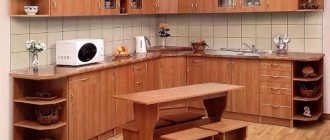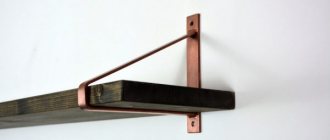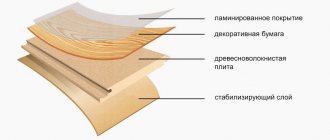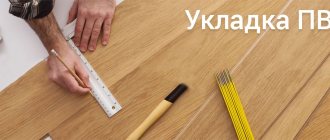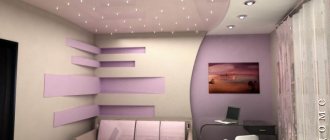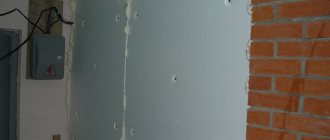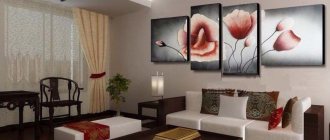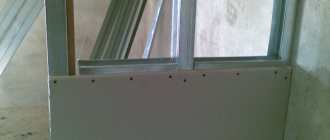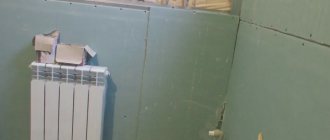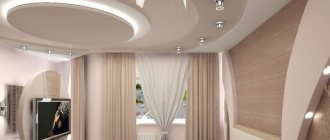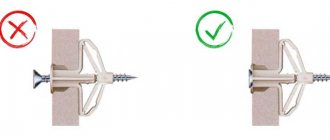When finishing walls in modern construction, plasterboard is most often used. This material is easy to use, has a smooth surface, and can be used to not only level walls, but also create full-fledged partitions and niches. However, there is an opinion that plasterboard structures, due to the characteristics of the material, are not suitable for placing LCD and plasma TVs on them. This opinion is wrong. If, before hanging a TV on a plasterboard wall, you follow all the technologies for attaching it to this building material, then no problems will arise in the future.
We hang TV on the wall
So, how do you install a TV on drywall?
There are several ways: - simply hang the TV on a sheet of drywall attached to the wall (provided the weight of the TV is insignificant); — build a special shelf (for TVs of medium size and weight); — large and heavy TFT panels are best simply installed in a niche, or supported on special well-fixed racks. Preparing a plasterboard niche for a large TV
In the first case, to hang the TV, you can get by with the most ordinary “butterfly” dowels, which “stitch” the gypsum board itself and the metal frame of the sheathing. With this installation of dowels, the load from the weight of the TV is distributed not along the back surface of the plasterboard sheet, but along the metal rack profiles.
Second stage of niche preparation
If you are the happy owner of a large, and, therefore, massive plasma panel, then hanging a TV on drywall will not be so easy. In this case, it is better to provide space in the interior of the room for the TV in advance. An original arch or niche made of plasterboard will be an excellent solution to the problem. Well, if you took up plasterboard shelves for a TV, then at the same time you can make niches for acoustics, a DVD player, shelves for discs and other sound and video equipment.
But what to do if the renovation has already been completely completed, all the walls are covered with plasterboard sheets and painted, and it becomes necessary to install a very massive TFT panel on the wall, without dismantling part of the wall for this in order to increase the load-bearing capacity of the frame?
Plasterboard niche for plasma TV with finishing and installed TV
In the case where the wall intended for installing a TV is load-bearing, the simplest and most correct solution would be to “drill” through the gypsum board into the surface of the wall and hang the TV using powerful dowels. In this case, the entire mass from the TV will be applied to the wall, and not to the plasterboard sheet, which is prone to crumbling.
But what if you need to install a heavy TV on a decorative plasterboard partition, the load-bearing capacity of which leaves much to be desired? If the partition is mounted, and internal reinforcement is not provided for in advance, then, willy-nilly, you will have to install additional external load-bearing racks. The most common metal pipes, I-beams, channels or other rolled metal capable of holding a given load can serve as such load-bearing elements when mounting a TV on drywall. The supports are installed vertically along the plasterboard partition and are firmly embedded in the floor, and, if possible, in the ceiling of the room. Such a reinforcing frame can be used to mount not only the most massive TV panel, but also all related equipment, including acoustics. Of course, such reinforcement may be somewhat disharmonious with the rest of the room’s decor, but with a little imagination, paint, chrome and something else in a similar style, it can be used as a special contrasting element of the interior.
Technical progress does not stand still, and we gradually began to wean ourselves from TVs with ray tubes - TFT panels and “plasma”, although not so quickly, but quite confidently replaced them. However, sometimes you need to solve the problem of installing just such a TV on a plasterboard wall.
Niches made of plasterboard for a TV with a ray tube will be too deep, dust will collect in them, and the heat exchange with such a TV installation will be insufficient. And installing such a TV on a simple plasterboard shelf is out of the question.
Bracket for a small TV, weighing up to 20kg
In such a situation, the best option would be to install the TV on a special console bracket - a “sleeve”. The fastening of such a “sleeve” usually occurs through a plasterboard sheet directly into the load-bearing wall. In this case, the mount must be powerful enough to hold the weight of the TV, taking into account the length of the “sleeve” arm, which significantly increases the stress in the cantilever seal.
Bracket for large plasma panel, weighing up to 80kg
If, when mounting a TV on drywall, you doubt the load-bearing capacity of any of the elements, then they should definitely be strengthened. After all, a broken TV (especially if it is a TFT or plasma panel) and a broken wall will affect not only your mood, but also the thickness of your wallet.
How to attach to a loose base
There is no single technology. Of course, each master chose his own method, tested by time and practice, but in fact, even in this case there is no point in talking about universality. It doesn't happen once at a time.
The easiest way to attach to a plaster wall
The simplest, but not the most reliable method of fastening is the use of self-tapping screws with large pitches (for wood). If the load is small and static, then a self-tapping screw screwed into a plaster wall will cope with it, but only if certain conditions for this method of fastening are met.
- The holes can be used only once. Once screwed in this way, unscrew it and then try to screw it in again, it will not work, i.e. you will return it again, but it will no longer be able to stay in this hole.
However, the condition of disposability applies to all holes, regardless of how they were made, even if their diameter is nominal or smaller.
- In any case, you need to press the last screw (1-2 threads) with your hands, otherwise there is a risk of turning the screw and destroying the wall material. Then all the work will go down the drain, and you will have to fasten it in some other way.
- It is necessary to take into account that with self-tapping screws of this type and (not only) the weak point is the neck of the bolt, the rod between the thread and the head. It is in this place that self-tapping screws most often break when tightening and when working on a bend. Therefore, you should not rely on one attachment point, but, if possible, increase their number.
Is it possible to hang a TV on drywall?
There is no clear answer to this question, since it’s all a matter of nuances. An important factor is the model and dimensions of the TV. Plasma with a large diagonal is risky to trust to a gypsum board wall, since the material will begin to crumble over time. But everything is possible if you resort to cunning - organize internal reinforcement.
If the model is light, then you can do without reinforcement. In this case, the TV is hung using special fasteners - butterfly dowels. Such a part is well fixed from the back of the gypsum board sheet. But you shouldn’t hang large equipment on them; this is available for models weighing up to 30 kg.
Thus, there are two options for equipment canopy:
- With reinforced internal frame. This method will require removing the sheathing material in the area of the TV canopy.
- Installation of a plasterboard wall on the skeleton profile.
Types of brackets for hanging a TV on a gypsum board wall.
It is permissible to use brackets: rigid and movable. The first type is more reliable, and therefore more suitable for fastening massive equipment. And movable brackets are more convenient for rooms that are original in shape or small in size, in order to turn the TV in the desired direction.
How to attach to plaster firmly and inexpensively
To do this, you need to use any other glue, as long as it is friendly with metal, if you plan to use a hairpin, or with polypropylene, if you are thinking of using a plastic dowel. For example, liquid nails, as in the picture. Such a tube, with a capacity of 300 ml, costs 115 rubles, and the cheapest and not the best chemical anchor (Tech-Krep stirol) costs more than 500 rubles.
As you can see, the difference is significant, but that’s not all.
The hole is possible, but if possible, if the hole is blind, it needs to be modified. Using a drill or other suitable tool, slightly increase the diameter of the hole at its bottom. You should get something similar to a cone-shaped recess.
Then you just fill the hole with glue, insert the desired fastening element, and wait for the glue to harden. It turns out relatively cheap, but very durable.
Choosing the right fasteners
The walls are usually lined with plasterboard sheets, 10-12 millimeters thick. The advantages of this material include high strength and resistance to heavy loads. The wall cabinet, together with its items, sometimes weighs more than 70 kg. Therefore, to prevent the fastening from breaking out, it is necessary to make the correct calculations and select the appropriate fasteners, taking into account the results obtained.
The advantage of fastening without installing mortgages is the ability to mount the cabinet directly on a lined wall. In other words, if a major renovation is not carried out in the room, the walls will not be dismantled, this option is considered the most suitable.
Unfortunately, fasteners like this that can withstand a lot of weight are very rarely sold.
Therefore, it is very important to know exactly which mount is suitable for a particular case.
The combined method is used only if, under the cladding made, the width of the installed mortgage, in some places does not correspond to the location of the hinges installed on the furniture being mounted.
Of course, any person can easily attach any furniture to a wall covered with plasterboard sheets, without the help of professional workers. This type of work does not require special experience. In this case, you can do without specific knowledge. The most important thing is to strictly follow the instructions.
The advantages of drywall have been well studied, but it is still considered the newest building material. This is due to the fact that some of its characteristics have not been fully tested. Therefore, before starting to use this material, it is advisable to consult with specialists. They will suggest the best mounting method, taking into account individual requirements.
We must not forget that any drywall cannot remain in a room with high humidity for a long time. Therefore, it is not suitable for finishing a bathroom. Over time, it will swell, strength will disappear, plasticity will appear, and the material will become very soft.
Furniture Wardrobe
What is the strength of gypsum walls
Before attaching anything to a plaster wall, let's look at the material it's made of. We are talking about tongue-and-groove slabs (TGP), which are now popular among builders. Builders are pleased with the ease of installation, operational efficiency and small amount of subsequent finishing.
Residents who live in apartments with interior and sometimes inter-apartment partitions made of tongue-and-groove slabs suffer from the disadvantages inherent in this building material. There are many shortcomings, but now we are only interested in strength.
What load can walls made of PGP withstand? On the Internet they write that at least 100 kg. Sounds vague, but what if 101, the wall collapses immediately? Therefore, you have to learn from your own and others’ experiences. I'll tell you about mine.
A storage water heater with a capacity of 75 liters and a dead weight of no less than 25 kg has been hanging on an 8 cm thick wall made of tongue-and-groove slabs for more than 8 years and does not seem to be going to fall.
Attaching the bracket to a plasterboard wall
Installing holding devices is not always easy; much depends on the characteristics of the surface. There are different methods selected for a specific situation.
Using dowels
Fixing heavy objects on plasterboard bases is carried out only if the fasteners are correctly selected. It is not allowed to use ordinary self-tapping screws that are screwed into a single-layer or two-layer surface. To hang the bracket, use a “molly”, “butterfly” or “driva” dowel. It is taken into account that each variety has certain weight restrictions.
Special fasteners for mounting heavy objects on drywall
Process algorithm:
The most suitable installation location is selected. To do this, the arrangement of interior items is analyzed from the point of view of convenience of visual perception.
This is especially true when using a fixed mechanism. It is important to consider the location of natural and artificial light sources that may interfere with viewing. The best option is to mount the mechanism on rack profiles or jumpers. This will make the fixation more secure. The mounting platform of the bracket is applied to the selected location, leveling is carried out using a level, after which the attachment points are marked
Holes are drilled according to the diameter of the dowel sleeve. You can't make the hole bigger, then you won't be able to tighten the screws tightly. The main part of the dowel is placed in the seat and, if necessary, knocked down a little with a hammer. The mounting holes in the wall and on the bracket are aligned, screws are screwed in sequentially
If the cap size is small, a washer must be installed. The mechanism must be fastened carefully: the holding occurs until all the screws are tightened. After this, you can hang and connect the equipment. The reliability of fixation is checked. Do not allow loosening or sagging
Do not allow loosening or sagging.
This method is recommended for installing equipment whose weight does not exceed 25 kg. To mount a TV on a plasterboard wall with a larger mass, it is necessary to use anchors, the mounting hole for which is created not only in the gypsum board slab, but also in the base.
Through fastening is considered one of the most effective hanging methods, but it can only be used if the distance from the load-bearing wall to the face of the plasterboard does not exceed 100 mmThrough mortgages
This is the optimal solution, especially if you need to hang a heavy structure. The method also ensures reliability when fixing mechanisms with protruding rotating elements.
Mortgages are included in the list of required parts when creating niches for installing a TV and equipment and installing an interior partition.
Fastening technology:
- Depending on the configuration of the embedded part, suitable screws are selected. Most often, a wooden beam is used for insertion into the frame, but there are options in which it is placed in a pre-assembled lintel from a profile. In such a situation, drilling of the metal part will be required.
- Markings are carried out according to the sheathing diagram and the location of the holes in the mounting areas of the bracket. When working, you must use a level to adjust the placement of the hinged mechanism.
- To avoid damage to the drywall, fastening points are pre-formed.
- It is also recommended to drill out the wooden beam. To do this, use a nozzle with a diameter smaller than the shaft of the selected screw. This allows you to avoid cracking of the mortgage, especially if the material is overdried.
- The bracket is positioned according to the mounting points and attached to several self-tapping screws with a washer. The necessary adjustments and final fixation are made.
This technology allows you to attach even heavy TVs to a retractable and rotating mechanism.
Methods for arranging mortgages for a TV
If the sheets are not yet attached with screws
It is always recommended to plan the placement of future items and equipment at the renovation stage. Especially if this concerns hinged mounting on non-load-bearing additional walls or partitions (in our case, plasterboard).
The best solution would be to install mortgages. These are wooden bars or boards that are fixed between metal profiles (posts) that form the frame of the wall.
- Profiles of suitable width are mounted between two racks using metal screws. Profiles should not protrude. All connections are made level with the outside of the frame.
- Beams or a solid board are laid into the inner surface of the profiles. The wooden element is attached with screws through the side of the profile.
On a finished wall, mounting holes should be made directly through the gypsum board into the embedded wall.
With individual thin bars there is a high risk of a miss. Therefore, it is better to use a solid wooden board as a mortgage.
It can be secured with the previously mentioned Hartmut dowel or wood screws.
How to mount a TV on a plasterboard wall
Increasingly, plasterboard is being used to level walls in apartments. But when the renovation is completed, it’s time to furnish the apartment. If it was not planned to mount the TV on a wall covered with plasterboard, then hanging the TV bracket can sometimes be problematic. Although drywall is not a load-bearing element, it can easily withstand the load from a TV weighing even 20 - 30 kg.
Plywood embed for attaching a TV bracket to a plasterboard wall
If you are thinking about mounting the TV before renovation, then you should provide a 12 mm thick plywood insert, which is screwed between the plasterboard frame studs. If the TV mount falls on two spaces between the racks, then you need to install two mortgages. They are attached to the studs at the corners and when a sheet of drywall is screwed to the studs, the drywall is additionally screwed to the plywood from the outside.
The height of the plywood embeds is 1 meter, the width is 60 or 40 cm, depending on the pitch of the racks. When you buy a TV for your apartment along with a bracket for attaching to the wall, the bracket is installed in place and screwed through the plasterboard to the plywood with 30 mm long wood screws. This mount is very reliable and has been used for a long time.
Attaching the bracket to drywall with dowels
Lightweight TVs can be hung on the wall using special dowels, which can bear a load of up to 25 kg. You can use metal screws or butterfly dowels. With this method of installing a TV bracket, it is better that one side is mounted on a metal stand. You can find it if you dismantle the socket installed near the TV, remove the socket and find the stands. They are installed strictly vertically, every 60 or 40 cm.
Fastening with long bolts and dowels to the main wall
For those who love reliability and solidity, in addition to simply attaching the TV bracket to drywall with dowels, you can suggest installing it with long dowels. You can buy them in stores that sell hardware. Plastic dowels with a long wrench bolt or screwdriver are sold as a set. There are different lengths and can be chosen for any situation.
The most radical way to mount an LCD TV on the wall
If the distance from the drywall to the wall is too large, for example more than 10 cm, then you can securely fix an LCD or heavy plasma TV on the wall only with the help of mortgages. You will have to make a hole in the drywall in order to insert the mortgages through it to attach the bracket. Mortgages can be made from strips of plywood or from a wide metal profile. The greater the length and area of the mortgages, the better.
The embeds are screwed with self-tapping screws through the drywall so that the mounting points of the bracket fit onto the embed. Embeds are installed under the hole, a piece of drywall is cut out and screwed to the embeds. Now you can putty the seams. sand and paint or wallpaper.
Will plasterboard be able to withstand the weight of an LCD TV?
It’s good if you thought about installing television equipment at the stage of creating the frame. Then it was possible to lay several embedded bars in the profile, to which brackets for the TV would then be attached. But is it possible to hang a TV on drywall if there are no mortgages? How much weight can a new wall withstand? Let's look into these issues together.
It all depends on the fasteners used. If you fix the TV brackets with ordinary self-tapping screws, screwing them into drywall, then nothing good will come of it. If you use special dowels, you can achieve the desired result.
The number of layers of drywall also plays an important role. If the wall is sheathed in two layers, then it will be able to support more weight than if it consisted of one layer of plasterboard.
The weight of the TV ranges from 10 to 35 kg, which largely depends on the manufacturer and the selected diagonal. One butterfly dowel can withstand 15 kg of load. If the drywall is laid in two layers, then one such dowel can withstand up to 25 kg of load. The Molly anchor can withstand even greater loads.
From here we make a logical conclusion that the drywall will support the weight of the TV, which will be mounted with 2-8 dowels (depending on the brackets that come with the LCD panel).
How to hang a TV on a plasterboard wall without a frame
You can attach the mount to frameless sheathing quite simply, but follow the following recommendations:
- Initially, even at the installation stage, it is necessary to securely fasten the sheets of plasterboard sheathing intended for fastening. This is done by screwing in self-tapping screws for gypsum boards, which will not allow the plasterboard panel to come off.
- Anchor bolts that are driven through the sheet are suitable as fasteners for the bracket. Also, in the case of soft material of load-bearing structures, crocodile dowels for drywall are excellent.
- The fastening algorithm is as follows:
- in the selected area for mounting the bracket, markings are made along which holes of the required diameter are drilled;
- The bracket is placed in the prepared place and fixed using the selected fastening materials.
When selecting anchors or dowels, it is important to calculate their load in advance, according to which they are selected
Making changes to the design
Such methods involve adding durable elements to the frame, allowing for reliable installation.
Use of mortgages
One of the easiest ways to attach brackets and hang other heavy objects. It is best to make mortgages from wooden beams at the stage of assembling the frame for sheathing with plasterboard.
An example of attaching a bracket to drywall. To do this, lumber of the appropriate cross-section is selected and attached to the wall with anchors or dowels. After finishing is completed, knowing the exact location of such areas, you can easily attach the bracket with dowels to the created durable structure.
The disadvantage of using such a scheme is that, if desired, it will not be possible to move the TV to another section of the wall.
This method is best used when attaching the bracket to a plasterboard partition that does not have a strong load-bearing wall.
The process of mounting a TV on drywall
Changes in gypsum board finishing
This option is suitable for attaching the bracket to a finished plasterboard finish. The method consists of cutting out a part of the sheathing to the size of the fastening and then fixing it to the load-bearing wall. It is worth knowing that this method is only possible with a small distance of plasterboard sheets from the main masonry. This is done in the following way:
- The finishing is marked according to the size of the bracket (along the contour);
- To cut drywall, you can use a regular stationery or construction knife. They gradually cut out the required section of wall cladding;
- A bracket is inserted into the resulting opening and fixed to the wall with standard dowels from the kit.
Choosing a bracket depending on the size and weight of the TV
Hanging is carried out according to a number of rules. Violations will lead to the fact that the fixation will be unreliable, and as a result the device may fall. When choosing a suitable bracket, it is taken into account that all modern fastening elements are produced in accordance with the international standard VESA (Video Electronics Standards Association), which determines the sequence of locations of fixing holes on the bracket and the TV.
Equipment comes in different sizes, so the standard includes several categories:
- VESA MIS-D. For this type of fastening devices, equipment with a diagonal of 10 to 29.9 inches is recommended. The fixing holes can be in two positions: 7.5 x 7.5 or 10 x 10 cm.
- VESA MIS-E. This variation allows you to place devices with screen sizes from 23″ to 30.9″ on the wall. The distance between the fastening points is 20 x 10 or 20 x 20 cm.
- VESA MIS-F. Involves installation of equipment with a diagonal of more than 31 inches. For this variety, there are many hole placement patterns, the most common are 20 x 20, 50 x 30 and 90 x 60 cm.
The suspension bracket is selected depending on the location of the mounting holes and the weight of the equipment
. To accurately determine the model of the bracket, you must read the instructions included with the TV, which indicate the required type and size or VESA designation. If there are no documents, you need to measure the distance between the holes with your own hands. It is taken into account that many manufacturers produce products that have several mounting point patterns.
Stages of work
The simplest option involves hanging a small-sized TV in the following way: insert fasteners - butterfly dowels - into the previously made holes;
Dowel "butterfly"
- use them to attach the bar with brackets;
- hang up the TV.
Note! Only liquid crystal models that have insignificant mass can be hung in this way. The weight of the equipment should not exceed 15 kg. Otherwise, the plasterboard wall will begin to collapse
This method involves installing only well-fixed fasteners that cannot be rotated. In this case, the weight of the device is evenly distributed over the outer side of the material. If the TV has a mass greater than 15 kg, then it is mounted on brackets. To do this you need to do the following operations:
Otherwise, the plasterboard wall will begin to collapse. This method involves installing only well-fixed fasteners that cannot be rotated. In this case, the weight of the device is evenly distributed over the outer side of the material. If the TV has a mass greater than 15 kg, then it is mounted on brackets. To do this you need to do the following operations:
- holes should be made in the drywall in the place where the metal profile is located underneath it. This way you can transfer the main load to the frame;
- We insert special fasteners - anchors - into the holes made with our own hands.
Anchor "Molly"
attach the bracket.
Now you can safely hang your TV on the prepared place in the plasterboard wall. If the model has quite a significant weight, and in addition to it you also want to install additional equipment (speakers, amplifiers, etc.), you need to make a shelf or niche. In such a situation, you need to install external supporting racks with your own hands. Their installation involves the following steps:
⦁ wooden beams or metal pipes, I-beams, channels, etc. can be used as load-bearing posts. Be sure to pre-treat the wood with an antiseptic solution.
Note! The main thing is that the selected rack option can support the required weight of the device
- we install the racks vertically along the wall;
- we embed them into the floor so that they do not wobble;
- sheets of drywall can be attached to the resulting frame;
- If necessary, we install horizontal shelves in the frame for additional equipment.
Elements of a load-bearing rack To give the racks an appropriate appearance and bring them into line with the interior of the room, you can use artificial stone, stucco or any other cladding for finishing. If you have a TV with a beam tube, then you can attach it to the wall either by forming an external supporting stand or using a sleeve bracket. A niche will not be suitable here at all, since the parameters of such a model will be too large for it. Remember! In such a situation, movable fastening elements cannot be used. A tilt-and-turn device can create a very large load on the wall due to the large lever in its design. As a result, the plasterboard wall will collapse very quickly. If you still decide to make a tilt-and-turn mechanism, then you need:
- secure it with screws;
- Fix only on metal profiles, under gypsum boards. Use a magnet to find them;
- the weight of the equipment should not be significant.
As you can see, you can install a TV of almost any weight and size on a plasterboard wall. You just need to strictly adhere to all the recommendations of specialists. It is best to provide in advance for strengthening the frame structure in the place of future fastening of heavy elements.
https://youtube.com/watch?v=D2LeJS3CrGk
How to correctly calculate a profile for plasterboard Plasterboard niches for TVs, selection and installation
What dowels are needed
To secure light objects, such as photo frames, you do not need to use advanced fasteners for heavy weights. All you need to do is screw in a drywall screw and hang a picture or something else.
If you fasten the TV receiver in this way, the screw will pop out of the drywall and the TV will fall to the floor. Therefore, a regular screw should never be used.
You need a special dowel designed for tangible loads.
- Screw dowel for drywall (DRIVA). No pre-drilling of the sheet is required for fastening. A plastic (or metal) dowel has an external thread, which is used to twist and fix it in plaster. The principle of operation is practically no different from an ordinary screw. But the significant difference lies in the area of the thread (screw). Due to the large protrusions, the screw is securely fixed in the sheet and can withstand a load of 5-10 kilograms or more. Not recommended for use on heavy items. A single fastening with a single-layer gypsum board can withstand 5-6 kg, with a two-layer one – up to 15.
- Butterfly dowel. It has a plastic sleeve, which opens when inserted into the hole. And when the screw is tightened, the side lobes of the sleeve begin to attract. By fixing the sheet on the back side, it will be possible to mount heavier TVs. The permissible load on one dowel for a single-layer material is about 10 kg, for a two-layer material – 25 kg. This is the first option that makes it possible to hang a TV on a plasterboard wall without complex reinforcing structures and actions. You just need to drill holes for the diameter of the dowel. Next, the part is threaded through the hole and twisted so that the petals tightly press the back side of the drywall.
- Dowel “Molly” (or “umbrella”). The holding principle is identical to the “butterfly”. Twisting leads to the opening of metal petals that look like an umbrella. Made of metal, which means the maximum load increases. If the sheathing is made of plasterboard in a single layer, then you can hang equipment up to 35 kg on one fastener.
- Dowel Knauf Hartmut (Knauf Hartmut).
The most reliable option for wall mounting a TV on drywall.Structurally, it is made of metal fasteners, plastic antennae and a pressure ring. The metal strip rests against the back of the wall, forming a support point for maximum area. With one 12.5 mm thick plasterboard sheet, a load of up to 35 kg can be attached. A two-layer plasterboard wall will withstand 55 kg. This means you don’t have to worry about the fastening being unreliable. Fully fastened with a wide mounting plate (rail) of the bracket on drywall will hold even the heaviest TV receiver.
Load values given are not accurate. Sometimes it turns out to hang things much heavier. But there should always be a margin of safety. Therefore, it is better to use the characteristics from fastener manufacturers.
The varieties "Molly", "butterfly" and Hartmut are intended only for hollow structures. This is necessary to insert the support part into the hole. There must be enough space behind the plasterboard sheathing to accommodate the fastening part of the dowel.
If the gypsum board is leaned against the wall without an intermediate frame, you can use a regular plastic dowel and a screw of the appropriate diameter. Both elements must be quite long in order to be securely fixed to the wall. When choosing parts, the thickness of the drywall is taken into account. The main load with this type of fastening falls on the wall (concrete or brick). And the installation technology does not differ from the standard version. First, holes are made in the wall for installing the bracket. Then the dowels are driven in, after which the bracket is secured to the wall with screws. Then the TV is hung on the wall.
How to install the wiring?
Everyone knows that the room is always equipped with sockets (connection points) that provide the power needed for household appliances. As a rule, they always install not only wall panels, but also other household appliances such as DVD players, video cameras, Wi-Fi routers. For this reason, it is necessary to take into account the load on the wiring and provide for the installation of more connection points. It is possible that you will need to hang additional shelves for placement. Before choosing a location for installation on the wall, be sure to consider how the wiring will run.
Wiring can be of two types.
- Open. This type does not meet high aesthetic requirements, since the cables are routed directly along the surface of the plasterboard walls. But such wiring has an undeniable advantage - it will allow you to complete the repair in a short time.
- Hidden. This type is popular because it makes all the wiring completely invisible to prying eyes, and this increases aesthetic requirements and the room becomes neat. All cable wiring is removed into the ceiling and floor plinths, only the places where they are connected to the outside where necessary remain visible.
Using specialized TV mounts on drywall
The use of hardware designed for hanging massive and heavy objects on plasterboard finishes allows you to fix quite large elements
As a material, you should pay attention to the following subtypes of dowels:
- An “umbrella” is a dowel that has “wings” that open under the drywall. Each fastener can withstand a load of up to 15 kg;
- dowel “mole”. Probably the simplest and most durable way to secure objects for finishing. “Mole” can withstand a load of up to 25 kg at each point. After screwing in the fastening bolt, the dowel opens, resting against the back side of the skin and distributing the load over the surface;
- wood A plastic dowel with a screw thread on the surface, due to which the fasteners are securely fixed in the thickness of the gypsum board panel. However, this method can be used to mount brackets for small TVs.
Attaching brackets to plasterboard trim is not particularly difficult; the main thing is to take into account the weight and dimensions of the TV that needs to be hung on the bracket, according to which you choose the installation method.
Common Mistakes
Due to inattentive reading of instructions or lack of practical experience, many people make mistakes during installation work. Below are some of the most common mistakes:
- Wrong choice of design. Purchasing and installing a mount that is not technically capable of supporting heavy loads will result in the TV tilting or toppling over.
- Unsafe mounting. All fasteners should be screwed into the drilled holes as deeply as possible. Otherwise they will relax and fall out.
- Deviation from instructions. If the installation sequence is incorrect, important parts may be missed and the fastening may be compromised.
- Insufficient number of fasteners. When installing, use all fasteners included with the hood.
How to install fasteners for equipment weighing more than 15 kg
Installation of such equipment in a suspended position cannot be carried out on structures that are entirely made of gypsum plasterboard. This procedure can only be carried out on concrete walls that are covered with a frame panel made of this material or simply covered with it. The work is carried out in the following order:
1. Places for driving fasteners are marked.
2. Drill holes in the plasterboard with a drill.
3. Using a hammer drill or impact drill, we make openings in the concrete (brick) wall.
4. Using a hammer, hammer the dowel from the expansion anchor into the hole.
5. Screw the anchor into the prepared socket. You need to tighten it all the way, since the spacers are located at the very end of the dowel.
6. We mount the equipment on fasteners.
In this case, the maximum permissible weight of the product together with the bracket is 40 kg.
The best option is to erect a structure frame with the expectation of future load on it. Laying additional reinforcing profiles or carving out a niche for the installation of equipment will remove the restriction on the permissible maximum weight and will serve as the key to a strong and reliable installation.
Interesting things on the site
Building your own home can legitimately claim to be one of the most important events in life. An important decision is the choice of material and construction technology, so we will...more. »
The foundation for a monolithic house can be a pile or strip foundation. A good solution is a slab base. The final choice directly depends on the analysis of the relief and soil, ...more. »
Construction technological processes are regularly improved. The usual panel and brick construction was replaced by a monolith. Many developers have appreciated this method and use it most often in ...more. »
Assessing the beneficial effects of water treatments with steam in a sauna on the body, many owners get excited about the idea of building their own bathhouse. Some men take their bathhouse as a basis, ...more. »
Chemical anchor
I won’t beat around the bush, in fact, behind this beautiful name there is simply glue, most often a two-component epoxy. The container used is a regular tube (300–410 ml) or a disposable ampoule, which must be inserted into a hole of suitable depth and diameter, and then insert a pin there and slowly tighten it. The pin will tear the ampoule shell, the glue composition, due to the twisting pin, will mix, fill all the cracks and recesses, and then you just have to wait for the glue to set. There will be more than enough time, so you can adjust the position of the hairpin if it has moved to the side.
Agree, it’s convenient. The cost of such an ampoule depends on its volume, which means the amount of glue, approximately 90–500 rubles. Don’t forget about the hairpin, another 15–180 rubles.
Installation of a frame for a TV made of plasterboard (video)
New liquid crystal and plasma models have already completely filled the market, because the image on them is better, and they can be placed much more conveniently, including hanging. To successfully fit the panel into the interior, you need to know how to attach the TV to the wall correctly and what is needed for this.
First of all, you need to decide on the type of fastening. Hanging the panel directly on the wall can be problematic, especially if you made plasterboard partitions: this option can only be considered for models weighing no more than 30 kg. Another method, more common, is to mount it on a bracket. In this case, two varieties of it are considered:
- hard;
- movable.
Rigid brackets are better used for heavy TVs because they are considered more reliable due to their immobility. On the other hand, by choosing a movable bracket, you can tilt or rotate the panel at an angle that suits you.
How to drill tongue-and-groove?
Use regular drills
on metal.
The third rule is to select the diameter of the drill
1 mm less than the selected dowel. Inserting the dowel into tension in the plaster is not a problem, but this way you will protect yourself from twisting the dowel itself when spreading with a self-tapping screw and increase the friction force.
Interesting materials:
How to make beef cook faster? How to prevent iPhone from charging from computer? How to make sure that pilaf does not burn? How can I make sure the font doesn't change? How can I make the link open in a new HTML tab? How to make snails reproduce? How can I make Google open in a new tab? How can I make words appear one after another in a presentation? How can I prevent VK from updating? How to collect stool for analysis for lactase deficiency?
